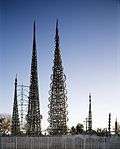Los Angeles Memorial Coliseum
The Los Angeles Memorial Coliseum is an American outdoor sports multi-purpose stadium located in the Exposition Park neighborhood of Los Angeles, California. Conceived as a hallmark of civic pride, the Coliseum was commissioned in 1921 as a memorial to L.A. veterans of World War I. Completed in 1923, it will be the first stadium to have hosted the Summer Olympics three times: 1932, 1984, and 2028.[12] It was declared a National Historic Landmark on July 27, 1984, the day before the opening ceremony of the 1984 Summer Olympics.[11]
The Grand Old Lady | |
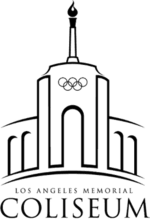 | |
 November 2019 Renovated interior view | |
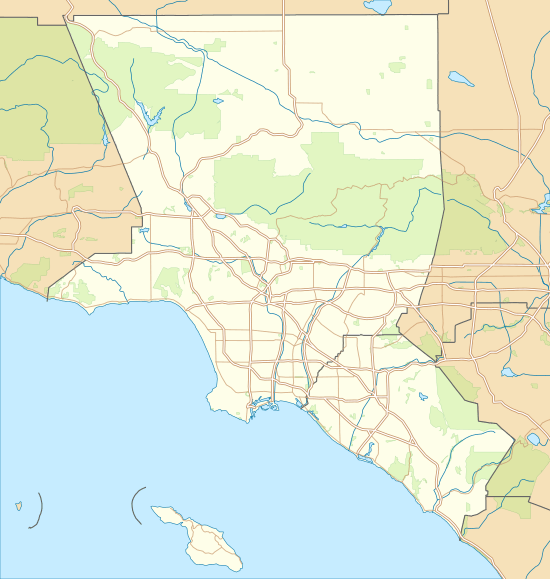 Los Angeles Memorial Coliseum Location in L.A. metro area  Los Angeles Memorial Coliseum Location in California  Los Angeles Memorial Coliseum Location in the United States | |
| Address | 3911 South Figueroa Street |
|---|---|
| Location | Los Angeles, California, U.S. |
| Coordinates | 34°0′51″N 118°17′16″W |
| Public transit | Expo/Vermont |
| Owner | City of Los Angeles, County of Los Angeles, State of California |
| Operator | University of Southern California |
| Executive suites | 42 |
| Capacity | 77,500 93,607 (pre-2018) [1][2] |
| Surface | Bermuda grass |
| Construction | |
| Broke ground | December 21, 1921 |
| Opened | May 1, 1923 |
| Renovated | 1930, 1964, 1977–78, 1983, 1993, 1995, 2011, 2017–2019 |
| Construction cost | US$954,872.98 (original)[3]($14.3 million in 2019 dollars[4]) $954,869 (renovations by USC in 2010) ($1.12 million in 2019 dollars[4]) $315 million (renovations by USC in 2018)[5][6][7] |
| Architect | John and Donald Parkinson (original) DLR Group (renovations) |
| General contractor | Edwards, Widley & Dixon Company (original)[3] Hunt & Hathaway Dinwiddie Construction Company (renovations) |
| Tenants | |
| USC Trojans (NCAA) (1923–present) Los Angeles Rams (NFL) (1946–1979, 2016–2019)[8] Los Angeles Christmas Festival (NCAA) (1924) UCLA Bruins (NCAA) (1933–1981) Los Angeles Dons (AAFC) (1946–1949) Pro Bowl (NFL) (1951–1972, 1979) Los Angeles Dodgers (MLB) (1958–1961) Los Angeles Chargers (AFL) (1960) Los Angeles Wolves (USA) (1967) Los Angeles Toros (NPSL) (1967) Los Angeles Aztecs (NASL) (1977, 1981) Los Angeles Raiders (NFL) (1982–1994) Los Angeles Express (USFL) (1983–1985) Los Angeles Dragons (SFL) (2000) Los Angeles Xtreme (XFL) (2001) Los Angeles Temptation (LFL) (2009–2011, 2015) LA Giltinis (MLR) | |
| Website | |
| www | |
Los Angeles Memorial Coliseum | |
.jpg) The Peristyle plaza entrance to the Coliseum, including the two bronze Olympic statues | |
| Area | 18 acres (7.3 ha) |
| Architectural style | Art Moderne[9] |
| NRHP reference No. | 84003866[10] |
| CHISL No. | 960 |
| Significant dates | |
| Added to NRHP | July 27, 1984 |
| Designated NHL | July 27, 1984[11] |
The stadium serves as the home to the University of Southern California (USC) Trojans football team of the Pac-12 Conference. USC, which operates and manages the Coliseum, granted naming rights to United Airlines in January 2018; after concerns were raised by Coliseum Commission, the airline became title sponsor of the playing field, naming it United Airlines Field at the Los Angeles Memorial Coliseum. The stadium is located in Exposition Park, which is owned by the State of California, and across the street from USC. The Coliseum is jointly owned by the State of California, Los Angeles County, City of Los Angeles and is managed and operated by the Auxiliary Services Department of the University of Southern California.[13]
It was the home of the Los Angeles Rams of the National Football League (NFL) from 1946 to 1979, when they moved to Anaheim Stadium in Anaheim. The Coliseum served as their home stadium again from 2016 to 2019 prior to the team's move to SoFi Stadium in Inglewood. The facility had a permanent seating capacity of 93,607 for USC football and Rams games, making it the largest football stadium in the Pac-12 Conference and the NFL.[14]
The stadium also was the temporary home of the Los Angeles Dodgers of Major League Baseball from 1958 to 1961 and was the host venue for games 3, 4, and 5 of the 1959 World Series. It was the site of the First AFL-NFL World Championship Game, later called Super Bowl I, and Super Bowl VII. Additionally, it has served as a home field for a number of other teams, including the 1960 inaugural season for the Los Angeles Chargers, Los Angeles Raiders of the NFL, and UCLA Bruins football.
From 1959 to 2016, the Los Angeles Memorial Sports Arena was located adjacent to the Coliseum; the Sports Arena was closed in March 2016 and demolished. Banc of California Stadium, a soccer-specific stadium and home of Major League Soccer's Los Angeles FC, was constructed on the former Sports Arena site and opened in April 2018.
USC began a major renovation of the stadium in early 2018.[15] During the renovation project the seating capacity was 78,467 and became 77,500 upon completion in 2019.[16] The $315 million project was completed by the 2019 football season and was the first major upgrade of the stadium in twenty years.[5] The project included replacing the seating along with the addition of luxury boxes and club suites.
Operation
The Coliseum is primarily the home of the USC Trojans football team. Most of USC's regular home games, especially the alternating games with rivals UCLA and Notre Dame, attract a capacity crowd. The current official capacity of the Coliseum is 77,500 with 42 suites, 1,100 club seats, 24 loge boxes, and 500-person rooftop terrace.[17][18] USC's women lacrosse and soccer teams use the Coliseum for selected games, usually involving major opponents and televised games.[19] USC also rents the Coliseum to various events, including international soccer games, musical concerts and other large outdoor events.[20]
USC
The Los Angeles Memorial Coliseum Commission, which consists of six voting members[21] appointed by the three ownership interests and meets on a monthly basis, provides public oversight of the master lease agreement with USC. Under the lease the University has day-to-day management and operation responsibility for both the Coliseum and Banc of California Stadium properties.[22] Up until 2013, USC had a series of mostly one- and two-year leases with the commission.[23] In July 2013, USC gained the master lease of the Coliseum, after the previously governing owner Coliseum Commission failed to deliver promised renovations.[24] The 98 year long agreement requires the University to make approximately $100 million in physical repairs to the Coliseum and in addition requires USC pay $1.3 million each year in rent to the State of California for the state owned land the Coliseum property occupies in Exposition Park, maintain the Coliseum's physical condition at the same standard used on the USC Campus, and assume all financial obligations for the operations and maintenance of the Coliseum and Banc of California Stadium Complex.[25][26][27][28]
History
Planning

The Coliseum was commissioned in 1921 as a memorial to L.A. veterans of World War I (rededicated to all United States veterans of World War I in 1968).[29] The groundbreaking ceremony took place on December 21, 1921, with construction being completed in just over 16 months, on May 1, 1923.[30] Designed by John and Donald Parkinson, the original bowl's initial construction costs were $954,873. When the Coliseum opened in 1923, it was the largest stadium in Los Angeles with a capacity of 75,144. In 1930, however, with the Olympics due in two years, the stadium was extended upward to seventy-nine rows seats with two tiers of tunnels, expanding the seating capacity to 101,574. The now-signature Olympic torch was added. For a time it was known as Olympic Stadium. The Olympic cauldron torch which burned through both Games remains above the peristyle at the east end of the stadium as a reminder of this, as do the Olympic rings symbols over one of the main entrances. The football field runs east to west with the press box on the south side of the stadium. The current jumbotrons to each side of the peristyle were installed in 2017 and replaced a scoreboard and video screen that towered over the peristyle dating back to 1983; they replaced a smaller scoreboard above the center arch installed in 1972, which in turn supplanted the 1937 model, one of the first all-electric scoreboards in the nation. Over the years new light towers have been placed along the north and south rims. The large analog clock and thermometer over the office windows at either end of the peristyle were installed in 1955. In the mid- and late 1950s the press box was renovated and the "Los Angeles Memorial Coliseum" lettering and Olympic rings, lighted at night, were added to the eastern face of the peristyle tower. Between the double peristyle arches at the east end is the Coliseum's "Court of Honor"—plaques recognizing many of the memorable events and participants in Coliseum history, including a full list of 1932 and 1984 Olympic gold medalists. (The complete roster of honorees can be seen below.)
Renovations
For many years the Coliseum was capable of seating over 100,000 spectators. In 1964 the stadium underwent its first major renovation in over three decades. Most of the original pale green wood-and-metal bench seating was replaced by individual theater-type chairs of dark red, beige, and yellow; these seats remained until 2018, though the yellow color was eliminated in the 1970s. The seating capacity was reduced to approximately 93,000.
The Coliseum was problematic as an NFL venue. At various times in its history, it was either the largest or one of the largest stadiums in the NFL. While this allowed the Rams and Raiders to set many NFL attendance records, it also made it extremely difficult to sell out. The NFL amended its blackout rule to allow games to be televised locally if they were sold out 72 hours before kickoff. However, due to the Coliseum's large size, Rams (and later Raiders) games were often blacked out in Southern California even in the teams' best years.
Partly due to this, from 1964 to the late 1970s it was common practice to shift the playing field to the closed end of the stadium and install end zone bleachers in front of the peristyle, limiting further the number of seats available for sale. For USC–UCLA and USC-Notre Dame games, which often attracted crowds upward of 90,000, the bleachers were moved eastward and the field was re-marked in its original position. When a larger east grandstand was installed in 1977–1978 at the behest of Rams owner Carroll Rosenbloom, the capacity was just 71,500. With the upcoming 1984 Summer Olympic Games, a new track was installed and the playing field permanently placed inside it. However, the combination of the stadium's large, relatively shallow design, along with the presence of the track between the playing field and the stands, meant that some of the original end zone seats were as far from the field by the equivalent length of another football field. To address these and other problems, the Coliseum underwent a $15 million renovation before the 1993 football season which included the following:[1]
- The field was lowered by 11 feet (3.4 m) and 14 new rows of seats replaced the running track, bringing the first row of seats closer to the playing field (a maximum distance of 54 feet (16.5 m) at the eastern 30-yard-line).
- A portable seating section was built between the eastern endline and the peristyle bleachers (the stands are removed for concerts and similar events).
- The locker rooms and public restrooms were modernized.
- The bleachers were replaced with individual seating.[31]
Additionally, for Raiders home games, tarpaulins were placed over seldom-sold sections, reducing seating capacity to approximately 65,000. The changes were anticipated to be the first of a multi-stage renovation designed by HNTB that would have turned the Coliseum into a split-bowl stadium with two levels of mezzanine suites (the peristyle end would have been left as is). However, after the 1994 Northridge earthquake, the $93 million was required from government agencies (including the Federal Emergency Management Agency) to repair earthquake damage, and the renovations demanded by the Raiders were put on hold indefinitely. The Raiders then redirected their efforts toward a proposed stadium at SoFi Stadium in Inglewood before electing to move back to the Oakland Coliseum prior to the 1995 NFL season. The last element of the Northridge earthquake repairs was the replacement of the condemned press box with a new press box in 1995.
New videoboard
In August 2011, construction began on the Coliseum's west end on a new 6,000-square-foot (560 m2) HD video scoreboard, accompanying the existing video scoreboard on the peristyle (east end) of the stadium.[32] The video scoreboard officially went into operation on September 3, 2011, at USC football's home opener versus the University of Minnesota, with the game being televised on ABC.
2018–2019 renovation project
After USC took over the Coliseum master lease in 2013, they began making plans for major renovations needed and as stipulated in the master lease agreement. On October 29, 2015, the University of Southern California unveiled an estimated $270-million project for a massive renovation and restoration the Coliseum.[33] The upgrades included: replacing all seats in the stadium, construction of a larger and modern press box (that contains new box suites, premium lounges, a viewing deck, V.I.P. section and introduction of LED ribbon boards), adding new aisles and widening some seats, a new sound system, restoration and renaming of the Peristyle to the Julia and George Argyros Plaza, stadium wide Wi-Fi, two new HD video jumbotrons and scoreboard, new concession stands, upgraded entry concourses, new interior and exterior lighting, modernization of plumbing and electrical systems, and a reduction in capacity of about 16,000 seats, with the final total at approximately 78,500 seats.[34]
The plans were met with mixed reactions from the public.[35] The Los Angeles 2028 Olympic bid committee contemplated additional renovations to support its bid.[36]
On Monday, January 8, 2018, the University began the project to renovate and improve the Coliseum. The project, which was solely funded by the University, was completed by the 2019 football season and was the first major upgrade of the stadium in 20 years.[37][15] The project budget increased from the initial estimate of $270 million to $315 million mainly due to the tight construction schedule.[5][7]
Naming rights
On January 29, 2018, Chicago, IL-based United Airlines, Inc. became the stadium's first naming rights partner.[2][12][38] Originally, Memorial Coliseum was to be retained in the name of the stadium by the condition of the Coliseum Commission's requirement in its master lease agreement with the University.[39] However, veterans groups and the new president of the Coliseum Commission raised concern about the new name,[40] while United Airlines did not approve of any change from United Airlines Memorial Coliseum and suggested that they were willing to step away from the deal.[41]
USC suggested on March 29, 2019 the name United Airlines Field at Los Angeles Memorial Coliseum instead of the planned United Airlines Memorial Coliseum. Although United Airlines also did not support this and considered withdrawal,[42] the two parties agreed to the name on June 7.[5]
During the Los Angeles Rams home games for the 2019 season, the stadium reverted to its original name "Los Angeles Memorial Coliseum," and all signage indicating "United Airlines Field" was covered due to the franchise's sponsoring partnership with American Airlines.[43]
Notable events
1920s
In 1923, Pomona College and USC played in the inaugural game at the Coliseum on October 6,[44] with the Trojans prevailing 23–7. Situated just across the street from Exposition Park, USC agreed to play all its home games at the Coliseum, a circumstance that contributed to the decision to build the arena.
From 1928 through 1981, the UCLA Bruins also played home games at the Coliseum. When USC and UCLA played each other, the "home" team (USC in odd-numbered years, UCLA in even), occupied the north sideline and bench, and its band and rooters sat on the north side of the stadium; the "visiting" team and its contingent took to the south (press box) side of the stadium. Excepting the mid-1950s and 1983–2007, the two teams have worn their home jerseys for the rivalry games for the Victory Bell; this tradition was renewed in 2008, even though the two schools now play at different stadiums. UCLA moved to the Rose Bowl in Pasadena in 1982.
1930s–1940s
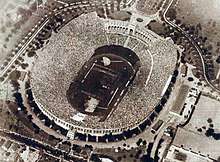
In 1932, the Coliseum hosted the 1932 Summer Olympic Games; the first of two Olympic Games hosted at the stadium. The Coliseum served as the site of the field hockey, gymnastics, the show jumping part of the equestrian, and the track and field events along with the opening and closing ceremonies.[45] The 1932 games marked the introduction of the Olympic Village as well as the victory podium.[11]
The former Cleveland Rams of the National Football League relocated to the Coliseum in 1946, becoming the Los Angeles Rams; but the team later relocated again, first to Anaheim in 1980, then to St. Louis, Missouri in 1995 only to move back to Los Angeles in 2016. The Los Angeles Dons of the All-America Football Conference played in the Coliseum from 1946 to 1949, when the Dons franchise merged with its NFL cousins just before the two leagues merged.[46]
The Coliseum hosted the NCAA Men's Division I Outdoor Track and Field Championships in 1934, 1939, 1949 and 1955.
1950s–1960s
Among other sporting events held at the Coliseum over the years were games of Major League Baseball, which were held at the Coliseum when the Brooklyn Dodgers of the National League relocated to the West Coast in 1958. The Dodgers played here until Dodger Stadium was completed in time for the 1962 season. Even allowing for its temporary status, the Coliseum was extremely ill-suited for baseball due to the fundamentally different sizes and shapes of football and baseball fields. A baseball field requires roughly 2.5 times more area than a football gridiron, but the playing surface was just barely large enough to accommodate a baseball diamond. As a result, foul territory was almost nonexistent down the first base line, but was very expansive down the third base line with a very large backstop for the catcher. Sight lines also left much to be desired; some seats were as far as 710 feet (216 m) from the plate. Also, from baseball's point of view, the locker rooms were huge, because they were designed for football (not baseball) teams.
In order to shoehorn even an approximation of a baseball field onto the playing surface, the left-field fence was set at only 251 feet (77 m) from the plate. This seemed likely to ensure that there would be many "Chinese home runs", as such short shots were called at the time, and sportswriters began jokingly referring to the improvised park as "O'Malley's Chinese Theatre"[47] or "The House that Charlie Chan Built", drawing protests from the Chinese American community in the Los Angeles area.[48] They also expressed concern that cherished home run records, especially Babe Ruth's 1927 seasonal mark of 60, might easily fall as a result of 250-foot (76 m) pop flies going over the left-field fence. Sports Illustrated titled a critical editorial "Every Sixth Hit a Homer!"[47] Players, too, complained, with Milwaukee Braves' ace Warren Spahn calling for a rule that would require any home run to travel at least 300 feet (91 m) before it could be considered a home run.[49]
Baseball Commissioner Ford Frick ordered the Dodgers to erect a 42 feet (12.8 m) screen in left field to prevent pop flies from becoming home runs. Its cables, towers, wires and girders were in play.[50] The "short porch" in left field looked extremely attractive to batters. In the first week of play during the 1959 season, the media's worst preseason fears seemed to be realized when 24 home runs were hit in the Coliseum, three of them by Chicago Cubs outfielder Lee Walls, not especially distinguished as a hitter. But pitchers soon adapted, throwing outside to right-handed hitters, requiring them to pull the bat hard if they wanted to hit toward left. Perhaps no player took better advantage than Dodgers outfielder Wally Moon, who figured out how to hit high fly balls that dropped almost vertically just behind the screen. By season's end, he had hit 19 homers, all but 5 of them in the Coliseum. In recognition, such homers were dubbed "Moon Shots."[49]
Nonetheless, the number of home runs alarmed Frick enough that he ordered the Dodgers to build a second screen in the stands, 333 ft (101 m) from the plate. A ball would have had to clear both screens to be a home run; if it cleared the first, it would have been a ground-rule double. However, the Dodgers discovered that the earthquake safety provisions of the Los Angeles building code forbade construction of a second screen.[49]
Unable to compel the Dodgers to fix the situation, the major leagues passed a note to Rule 1.04 stating that any stadium constructed after June 1, 1958, must provide a minimum distance of 325 feet (99 m) down each foul line. Also, when the expansion Los Angeles Angels joined the American League for 1961, Frick rejected their original request to use the Coliseum as a temporary facility.[51] This rule was revoked (or perhaps, simply ignored) when the Baltimore Orioles launched the "Retro Ballpark" era in 1993, with the opening of Camden Yards. With a right field corner of only 318 feet (97 m), this fell short. However, baseball fans heartily welcomed the "new/old" style, and all new ballparks since then have been allowed to set their own distances.
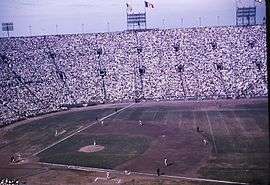
Late that season, the screen figured in the National League pennant race. The Braves were playing the Dodgers in the Coliseum on September 15, 1959, and Joe Adcock hit a ball that cleared the screen but hit a steel girder behind it and got stuck in the mesh. According to the ground rules, this should have been a home run. However, the umpires ruled it a ground-rule double. Then the fans shook the screen, causing the ball to fall into the seats. The umpires changed the call to a homer, only to change their minds again and rule it a ground-rule double.[50] Adcock was left stranded on second. The game was tied at the end of nine innings and the Dodgers won it in the tenth inning.[52] At the end of the regular season, the Dodgers and Braves finished in a tie. The Dodgers won the ensuing playoff and went on to win the World Series.
Although less than ideal for baseball due to its poor sight lines and short dimensions (left field at 251 feet (77 m) [mentioned above] and power alleys at 320 feet (98 m)) it was ideally suited for large paying crowds. Each of the three games of the 1959 World Series played there drew over 92,000 fans, with game 5 drawing 92,706, a record unlikely to be seriously threatened anytime soon, given the smaller seating capacities of today's baseball parks. A May 1959 exhibition game between the Dodgers and the New York Yankees in honor of legendary catcher Roy Campanella drew 93,103, the largest crowd ever to see a baseball game in the Western Hemisphere until an exhibition game in 2008 between the Los Angeles Dodgers and the Boston Red Sox to mark the 50th anniversary of MLB in Los Angeles. The Coliseum also hosted the second 1959 MLB All-Star Game.
The Coliseum was also the site of John F. Kennedy's memorable acceptance speech at the 1960 Democratic National Convention.[53] It was during that speech that Kennedy first used the term "the New Frontier".
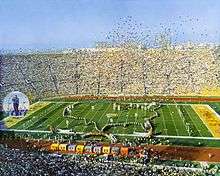
The Rams hosted the 1949, 1951, and 1955 NFL championship games at the Coliseum. The Coliseum was the site of the very first NFL-AFL Championship Game in January 1967, an event since renamed the Super Bowl. It also hosted the Super Bowl in 1973, but future Super Bowls in the Los Angeles region would instead be hosted at the Rose Bowl, which has never had an NFL tenant. The venue was also the site of the NFL Pro Bowl from 1951 to 1972 and again in 1979.
In 1960, the American Football League's Los Angeles Chargers played at the Coliseum before relocating to San Diego the next year; the team moved back to its original home in 2017.
The United States men's national soccer team played its first match as the stadium in 1965, losing to Mexico in a 1966 World Cup qualifier. Also, the Los Angeles Wolves of the United Soccer Association played their home games in the Coliseum for one year (1967) before moving to the Rose Bowl.
1970s–1980s
In July 1972, the Coliseum hosted the "Super Bowl" of Motocross. The event was the first motocross race held inside a stadium.[54] It has evolved into the AMA Supercross championship held in stadiums across the United States and Canada.
On August 20, 1972, Wattstax, also known as the "Black-Woodstock", took place in the Coliseum. Over 100,000 Black residents of Los Angeles attended this concert for African American pride. Later, in 1973, a documentary was released about the concert.
In 1973, Evel Knievel used the entire distance of the stadium to jump 50 stacked cars at the stadium. Knievel launched his motorcycle from atop one end of the Coliseum, jumping the cars in the center of the field, and stopping high atop the other end. The jump was filmed by ABC Wide World of Sports.[55] Also in 1973, the Coliseum was host to Super Bowl VII which saw the AFC champion Miami Dolphins (17–0) defeat the NFC champion Washington Redskins (13–4), 14–7, and become the only team in NFL history to attain an undefeated season and postseason.
The Los Angeles Rams played their home games in the Coliseum until 1979, when they moved to Anaheim prior to the 1980 NFL Season. They hosted the NFC Championship Game in 1975 & 1978 in which they lost both times to the Dallas Cowboys by lopsided margins.
The Los Angeles Aztecs of the North American Soccer League used the Coliseum as their home ground in both the 1977 and 1981 seasons.
The Coliseum was also home to the USFL's Los Angeles Express between 1983 and 1985. In this capacity, the stadium also is the site of the longest professional American football game in history; a triple-overtime game on June 30, 1984 (a few weeks before the start of the 1984 Summer Olympics) between the Express and the Michigan Panthers, which was decided on a 24-yard game-winning touchdown by Mel Gray of the Express, 3:33 into the third overtime to give Los Angeles a 27–21 win. Until 2012, this game marked the only time in the history of pro football that there was more than one kickoff in overtime play in the same game.[56]
In 1982, the former Oakland Raiders moved in. The same year, UCLA decided to move out, relocating its home games to the Rose Bowl in Pasadena.
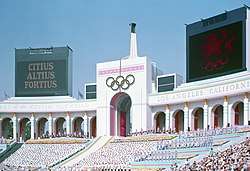
The Coliseum was also the site of the 1982 Speedway World Final, held for the first and, to this day, only time in the USA. The event saw Newport Beach native Bruce Penhall retain the title he had won in front of 92,500 fans at London's Wembley Stadium in 1981. An estimated 40,000 fans were at the Coliseum to see Penhall retain his title before announcing his retirement from motorcycle speedway to take up an acting role on the NBC drama series CHiPs.
Los Angeles hosted the 1984 Summer Olympics, and the Coliseum became the first stadium to host the Summer Olympic Games twice; again serving as the primary track and field venue and site of the opening and closing ceremonies.[57]
The Coliseum played host to the 2-day California World Music Festival on April 7–8, 1979.[58]
The Rolling Stones played at the stadium on their 1981 Tattoo You tour (October 9 & 11),[59] supported by George Thorogood, J. Geils Band, and a relatively unknown newcomer called Prince.
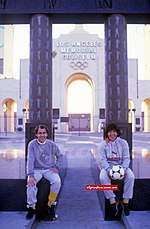
The Argentina national soccer team played a friendly match v Mexico on May 14, 1985,[60] as part of Argentina tour on North America prior to the 1986 FIFA World Cup that would be won by the squad managed by Carlos Bilardo.
Bruce Springsteen & The E Street Band concluded their Born in the U.S.A. Tour, with four consecutive concerts on September 27, 29–30 and October 2, 1985. These shows were recorded and eight songs from the show of September 30 appear on their box set, entitled Live 1975–85. The September 27 show was released through Springsteen's website on April 5, 2019.
U2 played at the stadium on leg 3 of their breakout Joshua Tree tour in 1987 with two consecutive nights, November 17 and 18, 1987. They later returned on their Pop Mart tour, June 21, 1997.
Los Angeles natives Mötley Crüe played at the stadium on December 13, 1987 during the second leg of their "Girls, Girls, Girls" World Tour with fellow heavy metal and Los Angeles-based band Guns N' Roses as the opening act. Mötley Crüe at the time was one of the most popular and successful musical acts on the planet, while Guns N' Roses was one of the largest up-and-coming acts. Guns N' Roses would later return for four shows in October 1989 as the opening act for The Rolling Stones, then again on September 27, 1992 on their infamous co-headlining tour with Metallica.
The stadium played host to The Monsters of Rock Festival Tour, featuring Van Halen, Scorpions, Dokken, Metallica and Kingdom Come, on July 24, 1988. A second show was planned to take place on the 23rd, but was later canceled.
The stadium also played host to Amnesty International's Human Rights Now! Benefit Concert on September 21, 1988. The show was headlined by Sting and Peter Gabriel and also featured Bruce Springsteen & The E Street Band, Tracy Chapman, Youssou N'Dour and Joan Baez.
1990s–2000s
The Raiders began looking to move out of the Coliseum as early as 1986. In addition to the delays in renovating the stadium, they never drew well; even after they won Super Bowl XVIII in 1984, they had trouble filling it. The NFL scheduled all of the Raiders' appearances on Monday Night Football as road games since the Los Angeles market would have been blacked out due to the Coliseum not being sold out. Finally, in 1995, the Raiders left Los Angeles and returned to Oakland, leaving the Coliseum without a professional football tenant for the first time since the close of World War II.
In the mid-1990s the Coliseum was planned to be the home of the Los Angeles Blaze, a charter franchise of the United League (UL) which was planned to be a third league of Major League Baseball (MLB).
The Legends Football League began as a halftime spectacular known as the Lingerie Bowl. The first 3 years (2004, 2005, 2006) were played at the Coliseum. From 2009 to 2011, a couple of Los Angeles Temptation games were played in the Coliseum. Beginning in 2015, the Temptation resumed playing at the Coliseum after 3 seasons at Citizens Business Bank Arena in Ontario.
The 1991 CONCACAF Gold Cup soccer tournament was also held at the Coliseum. The United States national team beat Honduras in the final. The Coliseum also staged the final match of the Gold Cup in the 1996, 1998, and 2000 tournaments. In October 2000, United States played its last match at the stadium in a friendly versus Mexico. Since then, the team has preferred the Rose Bowl Stadium and Dignity Health Sports Park as home stadiums in the Greater Los Angeles.
The stadium hosted the K-1 Dynamite!! USA mixed martial arts event. The promoters claimed that 54,000 people attended the event, which would have set a new attendance record for a mixed martial arts event in the United States; however, other officials estimated the crowd between 20,000 and 30,000.[61]
In May 1959, the Dodgers had hosted an exhibition game against the reigning World Series champion New York Yankees at the Coliseum, a game which drew over 93,000 people. The Yankees won that game 6–2. As part of their west coast 50th anniversary celebration in 2008, the Dodgers again hosted an exhibition game against the reigning World Series Champions, the Boston Red Sox.[62] The middle game of a three-game set in Los Angeles, held on March 29, 2008, was also won by the visitors, by the relatively low score of 7–4, given the layout of the field – Red Sox catcher Jason Varitek had joked that he expected scores in the 80s.
As previously mentioned in the 1950s–1960s section, during 1958–1961, the distance from home plate to the left field foul pole was 251 feet (76.5 m) with a 42-foot (13 m) screen running across the close part of left field. Due to the intervening addition of another section of seating rimming the field, the 2008 grounds crew had much less space to work with, and the result was a left field foul line only 201 ft long (61.3 m), with a 60-foot (18 m) screen, which one Boston writer dubbed the "Screen Monster".[63] Even at that distance, 201 feet (61 m) is also 49 ft (14.9 m) short of the minimum legal home-run distance. This being an exhibition game, balls hit over the 60 ft (18 m) temporary screen were still counted as home runs. There were only a couple of home runs over the screen, as pitchers adjusted (and Manny Ramirez did not play).[64] A diagram ([65]) illustrated the differences in the dimensions between 1959 and 2008:
- 2008 – LF 201 ft (61.3 m) – LCF 280 ft (85.3 m) – CF 380 ft (115.8 m) – RCF 352 ft (107.3 m) – RF 300 ft (91.4 m)
- 1959 – LF 251 ft (76.5 m) – LCF 320 ft (97.5 m) – CF 417 ft (127.1 m) – RCF 375 ft (114.3 m) – RF 300 ft (91.4 m)
A sellout crowd of 115,300 was announced,[66] which set a Guinness World Record for attendance at a baseball game, breaking the record set at a 1956 Summer Olympics baseball demonstration game between teams from the US and Australia at the Melbourne Cricket Ground.
The Coliseum formerly hosted the major U.S. electronic dance music festival Electric Daisy Carnival. It last hosted the event in 2010; following the drug-related death of an underage attendee at EDC that year, the festival's organizer Insomniac Events was blacklisted from hosting future events at the venue, and it subsequently moved to Las Vegas Motor Speedway beginning in 2011.[67][68][69][70][71]
In 2006, the Coliseum Commission focused on signing a long-term lease with USC; the school offered to purchase the facility from the state but was turned down. After some at-time contentious negotiations, with the university threatening in late 2007 to move its home stadium to the Rose Bowl, the two sides signed a 25-year lease in May 2008 giving the Coliseum Commission 8% of USC's ticket sales, approximately $1.5 million a year, but commits the agency to a list of renovations.[72]
In 2006, the Mexican group RBD held a concert during the RBD Tour USA for more than 70,000 people, the tickets sold out in less than 30 minutes. It was the highest attended event by a Mexican Musical group since Los Bukis' 1993 and 1996 concerts. Artists[73]
On June 23, 2008, the Los Angeles Memorial Coliseum Commission announced they were putting the naming rights of the Coliseum on the market, predicting a deal valued at $6 million to $8 million a year.[72] The funds would go towards financing more than $100 million in renovations over the next decade, including a new video board, bathrooms, concession areas and locker rooms.[72] Additional seating was included in the renovation plans which increased the Coliseum's seating capacity to 93,607 in September 2008.[74][75]
On June 17, 2009, the Coliseum was the terminus for the Los Angeles Lakers 2009 NBA Championship victory parade. A crowd of over 90,000 attended the festivities, in addition to the throngs of supporters who lined the 2-mile (3.2 km) parade route. The Coliseum peristyle was redesigned in purple and gold regalia to commemorate the team and the Lakers' court was transported from Staples Center to the Coliseum field to act as the stage. Past parades had ended at Staples Center, but due to the newly constructed L.A. Live complex, space was limited around the arena.[76]
2010s–present
On July 30, 2011, the LA Rising festival with Rage Against the Machine, Muse, Rise Against, Lauryn Hill, Immortal Technique and El Gran Silencio was hosted at the Coliseum.
On April 27, 2013, the stadium hosted the Stadium Super Trucks.[77]
On September 13, 2014, the Coliseum hosted the 5th-place game, 3rd-place game, and Final of the 2014 Copa Centroamericana in front of 41,969 spectators.
In August 2015, the Coliseum hosted the Opening and Closing Ceremonies for the 2015 Special Olympics World Summer Games.[78]
Los Angeles Rams

On January 12, 2016, the NFL gave permission for the St. Louis Rams to relocate back to Los Angeles. The Rams resumed play at the Coliseum, while awaiting completion of SoFi Stadium in Inglewood.[79][80]
On August 13, 2016, the Coliseum hosted its first NFL game at the stadium since 1994, as the Rams hosted Dallas Cowboys at a preseason game to a crowd of 89,140 people. On September 18, 2016, the Coliseum hosted the first Rams regular season home game since 1979, against the Seattle Seahawks.
On January 6, 2018, the Coliseum hosted its first Rams playoff game since the 1978 NFC Championship game, against the defending NFC champion Atlanta Falcons.
On November 19, 2018, the Coliseum hosted its first Monday Night Football game since 1985, and the first Monday night game the Rams hosted at the Coliseum, exact date 40 years later, with the Rams taking on the Kansas City Chiefs. That game, which was originally scheduled to be played at Estadio Azteca in Mexico City that night, was moved to the Coliseum due to poor field conditions at the former. The Rams won the game, 54–51 in the highest-scoring game in Monday Night Football history.
International soccer
In September 2018, the Coliseum held an International Friendly between Guatemala and Argentina.
| Date | Competition | Team | Result | Team |
|---|---|---|---|---|
| 7 September 2018 | International friendly | 0–3 |
2028 Summer Olympics
Los Angeles will host the Summer Olympics in 2028.[81] During the 131st IOC Session, the International Olympic Committee officially awarded the 2028 Summer Olympics to Los Angeles on July 31, 2017.[82][83] The Coliseum will be the first stadium to host events for three different Olympic games.[12]
Seating and attendance
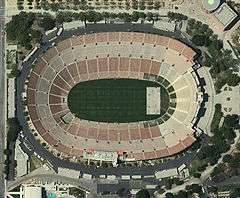
Seating capacity (college football)
| Years | Capacity |
|---|---|
| 1923–1930 | 75,144 |
| 1931–1934 | 101,574 |
| 1935–1939 | 105,000 |
| 1940–1946 | 103,000 |
| 1947–1964 | 101,671 |
| 1965–1966 | 97,500 |
| 1967–1975 | 94,500 |
| 1976–1982 | 92,604 |
| 1983–1995 | 92,516 |
| 1996–2007 | 92,000 |
| 2008–2017 | 93,607 |
| 2018 | 78,500 |
| 2019–present | 77,500 |
- Source:Ballparks.com[84]
Attendance records
1963 Billy Graham Crusade
The largest gathering in the Coliseum's history was a Billy Graham crusade which took place on September 8, 1963 with 134,254[85] in attendance, noted by the Coliseum's website as an all-time record. With the renovations of 1964, the capacity of the Coliseum was reduced to roughly 93,000 for future events.
Sporting events
- College football
Records differ between the 2006 USC football media guide and 2006 UCLA football media guide. (This may be due to only keeping records for "home" games until the 1950s.) The USC Media guide lists the top five record crowds as:
- 1. 104,953 — vs. Notre Dame 1947 (USC home game; Highest attendance for a football game in the Coliseum)
- 2. 103,303 — vs. UCLA 1939 (USC home game)
- 3. 103,000 — vs. USC 1945 (UCLA home game)
- 4. 102,548 — vs. USC 1954 (UCLA home game)
- 5. 102,050 — vs. UCLA 1947 (USC home game)
The UCLA Media guide does not list the 1939 game against USC, and only lists attendance for the second game in 1945 for Coliseum attendance records. These are the top three listed UCLA record Coliseum crowds:
- 1. 102,548 — vs. USC 1954 (UCLA home game)
- 2. 102,050 — vs. USC 1947 (UCLA home game)
- 3. 100,333 — vs. USC 1945 (USC home game; 1945's second of two meetings)
The largest crowd to attend a USC football game against an opponent other than UCLA or Notre Dame was 96,130 for a November 10, 1951 contest with Stanford University. The largest attendance for a UCLA contest against a school other than USC was 92,962 for the November 1, 1946 game with Saint Mary's College of California.
- National Football League
The Los Angeles Rams played the San Francisco 49ers before an NFL record attendance of 102,368 on November 10, 1957. This was a record paid attendance that stood until September 2009 at Cowboys Stadium, though the overall NFL regular season record was broken in a 2005 regular season game between the Arizona Cardinals and San Francisco 49ers at Azteca Stadium in Mexico City.[86][87] Both records were broken on September 20, 2009 at the first regular season game at Cowboys Stadium in Arlington, Texas between the Dallas Cowboys and New York Giants.
In 1958 the Rams averaged 83,680 for their six home games, including 100,470 for the Chicago Bears and 100,202 for the Baltimore Colts.
In their 13 seasons in Los Angeles the Raiders on several occasions drew near-capacity crowds to the Coliseum. The largest were 91,505 for an October 25, 1992 game with the Dallas Cowboys, 91,494 for a September 29, 1991 contest with the San Francisco 49ers, and 90,380 on January 1, 1984 for a playoff game with the Pittsburgh Steelers.
The Coliseum hosted the first AFL-NFL World Championship Game, later called the Super Bowl. The January 15, 1967 game, pitting the Green Bay Packers against the Kansas City Chiefs, attracted 61,946 fans—a lower-than anticipated crowd (by comparison, a regular-season game between the Packers and Rams a month earlier drew 72,418). For Super Bowl VII in 1973, which matched the Miami Dolphins against the Washington Redskins, the attendance was a near-capacity 90,182, a record that would stand until Super Bowl XI at the Rose Bowl. The 1975 NFC Championship Game between the Los Angeles Rams and Dallas Cowboys had an attendance of 88,919, still the largest crowd for a conference championship game since the conference-title format began with the 1970 season. The 1983 AFC Championship Game between the Raiders and Seattle Seahawks attracted 88,734.
The Rams' first NFL game at the Coliseum since 1979, after spending fifteen years at Anaheim Stadium and then twenty-one seasons in St. Louis, a pre-season contest against the Cowboys on August 13, 2016, drew a crowd of 89,140. The team's first regular-season home game, on September 18 against the Seattle Seahawks, attracted 91,046—the largest attendance for a Rams game at the Coliseum since 1959.
- Major League Baseball
Contemporary baseball guides listed the theoretical baseball seating capacity as 92,500. Thousands of east-end seats were very far from home plate, and were not sold unless needed. The largest regular season attendance was 78,672, the Dodgers' home debut in the Coliseum, against the San Francisco Giants on April 18, 1958.
The May 7, 1959, exhibition game between the Los Angeles Dodgers and the 1958 World Series Champion New York Yankees, in honor of disabled former Dodgers catcher Roy Campanella, drew 93,103, which was a Major League Baseball record prior to 2008.
All three Dodgers home games in the 1959 World Series with the Chicago White Sox exceeded 90,000 attendance. Game 5 drew 92,706 fans, a major league record for a non-exhibition game.
The attendance for the exhibition game on March 29, 2008, between the Boston Red Sox and the Los Angeles Dodgers, was 115,300,[88] setting a new Guinness World Record for attendance at a baseball game. The previous record of an estimated 114,000 was in the 1956 Summer Olympics at Melbourne Cricket Ground for an exhibition game between teams from branches of American Military Forces and Australia.
- Soccer
The first official soccer match at the Coliseum was an international fixture between the United States and Mexico that took place on March 7, 1965, as part of regional World Cup qualification. The teams drew 2–2 in front of 22,570 spectators.[89] The Coliseum has since become one of the most-used soccer venues for the U.S. national team, having hosted them twenty times, and for Mexico, who have played there 61 times since the mid 1980s.
The stadium hosted the Los Angeles Wolves during the inaugural season of the United Soccer Association in 1967, which culminated in the final championship at the Coliseum. The Los Angeles Toros of the National Professional Soccer League also played at the Coliseum in 1967, but were moved to San Diego the following season before folding.[90] The Los Angeles Aztecs of the North American Soccer League played at the Coliseum in 1977 and 1981 between stints at the Rose Bowl.[91]
Sculpture and commemorations
A pair of life-sized bronze nude statues of male and female athletes atop a 20,000 pound (9,000 kg) post-and-lintel frame formed the Olympic Gateway created by Robert Graham for the 1984 games. The statues, modeled on water polo player Terry Schroeder[92] and long jumper from Guyana, Jennifer Inniss, who participated in the games, were noted for their anatomical accuracy. A decorative facade bearing the Olympic rings was erected in front of the peristyle for the 1984 games, and the structure remained in place through that year's football season. The stadium rim and tunnels were repainted in alternating pastel colors that were part of architect Jon Jerde's graphic design for the games; these colors remained until 1987.
"Court of Honor" plaques
"Commemorating outstanding persons or events, athletic or otherwise, that have had a definite impact upon the history, glory, and growth of the Los Angeles Memorial Coliseum"[93]
- 1959 Dodgers World Series, 1961
- 50th Anniversary of Armistice, 1969
- John C. Argue, 2004
- Count Baillet-Latour, 1964
- Elgin Baylor, 2009
- Joan Benoit, 2017
- Billy Graham Crusade, 1963 September 8[94]
- Judge William A. Bowen, 1955
- Coliseum Commission – 1984 Olympics, 1984
- Coliseum Commission (1933–1944), 1970
- Coliseum Commission (1945–1970), 1970
- Coliseum Commission (1971–1998), 1998
- Coliseum Track and Field Records, 2002
- Community Development Association, 1932
- Pierre de Coubertin, 1958
- Newell "Jeff" Cravath, 1960
- Dean Bartlett Cromwell, 1963
- Anita DeFrantz, 2017
- Mildred "Babe" Didrickson, 1961
- Earthquake Restoration, 1999
- John Ferraro, 2000
- John Jewett Garland, 1972
- William May Garland, 1949
- Kenneth F. Hahn, 1993
- Elmer "Gus" Henderson, 1971
- Paul Hoy Helms, 1956
- Elroy "Crazy Legs" Hirsch, 2005
- Israeli Olympic Athletes, 1984
- Pope John Paul II, 1987
- Howard Harding Jones, 1955
- President John F. Kennedy, 1964
- Francis "Frank" Leahy, 1974
- Nelson Mandela, 2014
- James Francis Cardinal McIntyre and Mary's Hour, 1966
- John McKay, 2001
- Mercy Bowl, 1961
- J.D. Morgan, 1984
- Jesse P. Mortensen, 1963
- Jim Murray, 1999
- William Henry "Bill" Nicholas, 1990
- Walter F. O'Malley, 2008
- James Cleveland "Jesse" Owens, 1984
- Charles W. Paddock, 1955
- Rams Reunion, 2007
- Daniel Farrell Reeves, 1972
- Jackie Robinson, 2005
- Knute Rockne, 1955
- Pete Rozelle, 1998
- Henry Russell "Red" Sanders, 1959
- W.R. "Bill" Schroeder, 1990
- Vin Scully, 2008
- Andrew Latham "Andy" Smith, 1956
- William Henry "Bill" Spaulding, 1971
- Amos Alonzo Stagg, 1965
- Brice Union Taylor, 1975
- USC All-Americans (1880–2005), 2007
- Glenn Scobey "Pop" Warner, 1956
- Kenneth Stanley Washington, 1972
- Jerry West, 2009
- John R. Wooden, 2008
Olympic Cauldron
The Olympic cauldron was built for the 1932 Summer Olympics and was also reused during the 1984 Summer Olympics. The cauldron is a main sight on stadium and is still present in the Stadium and is lit during special events (such as the period when an edition of the Olympic Games are being held in another city or in mourning for some personality related to the city). As the stadium was the main venue on the 2015 Special Olympics World Summer Games the cauldron was relit by Rafer Johnson during the opening ceremonies and being extinguished again during the closing ceremony.
In addition, the torch has been lit on the following historic occasions:
- To honor the memory of Israeli athletes killed during the terrorist attack during the 1972 Summer Olympics in Munich.
- For several days following the Space Shuttle Challenger disaster in 1986.
- For over a week following the September 11 attacks in 2001.
- The pyre was lit for a week without interruption during the official period of mourning after the death of the former American president Ronald Reagan. Reagan was the president of the United States when the city of Los Angeles hosted the 1984 Summer Olympics and also declared that edition of the Games open.
- In April 2005 following the death of Pope John Paul II, who had celebrated Mass at the Coliseum during his visit to Los Angeles in 1987.
- At the Los Angeles Dodgers' 50th anniversary game on March 29, 2008, during the ThinkCure! charity ceremony (while Neil Diamond's "Heartlight" was played and the majority of the attendees turned on their complimentary souvenir keychain flashlights).
- For the returning Los Angeles Rams' first home game on September 18, 2016 against the Seattle Seahawks.
- On the evening of September 13, 2017, when Los Angeles was awaiting a few hours before the confirmation as the host city of the 2028 Summer Olympics.
- For the Coliseum Gladiator MMA Championship Finals on Sat. September 23, 2017.
- For the Los Angeles Rams' first playoff game in Los Angeles in 38 years on January 6, 2018 against the Atlanta Falcons.
- To honor the victims of the 2018 California wildfires & the Thousand Oaks shooting.
- For the Los Angeles Rams' playoff game against the San Francisco 49ers on December 30, 2018.
- For the Los Angeles Rams' playoff game against the Dallas Cowboys on January 12, 2019.
- To honor Kobe Bryant after his death on January 26, 2020.
In popular culture
Film
- 1923: Scenes from the Roman Age in Buster Keaton's Three Ages were filmed in the Coliseum. First ever use of the Coliseum as a movie location.
- 1927: Scenes in College a 1927 comedy-drama silent film directed by James W. Horne and Buster Keaton, and starring Keaton, Anne Cornwall, and Harold Goodwin are filmed on the field of the Coliseum.
- 1972: The Coliseum was used in the filming of Hickey & Boggs. There is an gunfight that takes place within the stadium.
- 1976: The Coliseum was the key location in the movie Two Minute Warning.
- 1978: The Coliseum was used in the filming of Warren Beatty's film Heaven Can Wait, about a fictional Super Bowl XII game between the Pittsburgh Steelers & the Los Angeles Rams.
- 1996: The Coliseum was used in the filming of Escape from L.A. starring Kurt Russell, including a basketball death match.
- 1997: it is used during the 1997 movie Money Talks starting Chris Tucker and Charlie Sheen.
Television
- 1972: The Coliseum was a key location in the Columbo The Most Crucial Game episode.
- 1978: The Coliseum was used in the filming of The Incredible Hulk episode titled "Killer Instinct".
- 2003: The Coliseum was used in the filming of the last episode of the second season of the television series 24.[95]
- 2008: The Coliseum was used as the starting point of the premiere episode of The Amazing Race 13.[96]
- 2016: The Coliseum was used as the finishing point for the second episode of the Chinese reality show Race the World.[97]
- 2019: Season 17 of Bravo's Top Chef filmed an episode at the Coliseum at the 1923 Club on the roof of the new Scholarship Club Tower.[98]
Video games
- 2004/2013: The Maze Bank Arena featured in Grand Theft Auto San Andreas and Grand Theft Auto V has an outer wall and arch similar to the Coliseum, but has a roof.[99]
- 2011: The Coliseum featured as a Rally cross track in Dirt 3.
See also
- Banc of California Stadium
- List of NCAA Division I FBS football stadiums
- History of the National Football League in Los Angeles
People
- A.J. Barnes, active in fight against giving USC preferential rights in the Coliseum, 1932
- Lloyd G. Davies, Los Angeles City Council member, 1943–51, urged that the city take over full management of the Coliseum
- Harold A. Henry, Los Angeles City Council president and later a member of the Coliseum Commission
- Rosalind Wiener Wyman, first representative of the Los Angeles City Council on the Coliseum Commission, 1958
- Ransom M. Callicott, Los Angeles City Council, commission member, 1962
References
- "Memorial Coliseum". University of Southern California. 2009. Archived from the original on March 2, 2010. Retrieved March 28, 2010.
- Thiry, Lindsey - USC Trojans' home is now officially the United Airlines Memorial Coliseum. Los Angeles Times, January 29, 2018.
- Benson, Michael (1989). Ballparks of North America: a comprehensive historical reference to baseball grounds, yards, and stadiums, 1845 to present. McFarland. ISBN 0-89950-367-5.
- Federal Reserve Bank of Minneapolis. "Consumer Price Index (estimate) 1800–". Retrieved January 1, 2020.
- "The University of Southern California and United Airlines Agree to Field Naming". USC Trojans. June 7, 2019. Retrieved June 7, 2019.
- "USC kicks off $270 million renovation of Coliseum - USC News. January 29, 2018". www.usc.edu.
- Kaufman, Joey (May 31, 2018). "USC's Coliseum renovation about $30 million over budget". Orange County Register. Retrieved June 1, 2018.
- "General FAQs". welcomehomerams.com. Los Angeles Rams. January 18, 2016. Archived from the original on January 17, 2016. Retrieved January 18, 2016.
Where will the Rams play? For the first three seasons we'll play at the L.A. Coliseum. In 2019, we'll move into the most advanced, world-class stadium ever built located in Inglewood, CA.
- Charleton, James H. (June 21, 1984). "Los Angeles Memorial.Coliseum" (pdf). National Register of Historic Places – Inventory Nomination Form. National Park Service. Retrieved May 22, 2012.
- "National Register Information System". National Register of Historic Places. National Park Service. July 9, 2010.
- Los Angeles Memorial Coliseum Archived November 14, 2007, at the Wayback Machine, National Landmarks Program, National Park Service, Accessed November 12, 2007.
- Mackovich, Ron (January 29, 2018). "United Airlines Memorial Coliseum to be new name for L.A. landmark". USC News.
- "USC Auxiliary Services".
- "Don't judge Rams home attendance based on percentage of seats filled". December 6, 2016.
- "The USC Coliseum Renovation Project Website". Archived from the original on February 26, 2018. Retrieved January 20, 2018.
- "Coliseum renovation reaches halfway point with topping-off ceremony". USC News. August 15, 2018.
- "LA Memorial Coliseum Completes $315M Renovation Ahead Of Football Season". August 15, 2019. Retrieved August 29, 2019.
- "RESTORING A CLASSIC: THE L.A. COLISEUM – Los Angeles Coliseum". Retrieved August 29, 2019.
- , " Trojans Women Soccer team Battle With No. 1 Bruins at LA Coliseum"
- , "LA Memorial Coliseum & Sports Arena Booking Information"
- "Los Angeles Memorial Coliseum Commission > About Us". lamcc.lacounty.gov. Retrieved January 25, 2018.
- "Second Amendment to Lease and Agreement by and between the Los Angeles Memorial Coliseum Commission and University of Southern California effective July 29, 2013". www.lamcc.lacounty.gov.
- Sam Farmer, Coliseum panel mulls options, Los Angeles Times, June 6, 2007.
- USC to take over L.A. Coliseum, Sports Arena on Monday LATimes
- , "ESPN. Board approves Coliseum lease" June 26, 2013
- , "USC signs historic lease agreement with LA Coliseum" September 5, 2013
- Barry Paskiewietz, Board approves Coliseum lease
- "Second Amendment to Lease and Agreement By and Between Los Angeles Memorial Coliseum Commission and University of Southern California" (PDF). July 29, 2013. Archived from the original (PDF) on May 26, 2014. Retrieved January 5, 2015.
- "Los Angeles Memorial Coliseum". Los Angeles Conservancy. Retrieved March 30, 2019.
- Los Angeles Memorial Coliseum Archived October 19, 2006, at the Wayback Machine
- Stadiums of the NFL-Los Angeles Coliseum-Los Angeles Rams/Raiders Archived February 5, 2007, at the Wayback Machine
- "USC Official Athletic Site – USCTrojans.com". www.usctrojans.com.
- "USC PROPOSES ESTIMATED $270-MILLION RENOVATION PLAN FOR LA COLISEUM". ABC 7 Los Angeles. October 29, 2015. Retrieved October 31, 2015.
- "USC Official Athletic Site – USCTrojans.com". www.usctrojans.com.
- "Coliseum renovation a hot topic among USC Trojans faithful".
- "LA Coliseum To Undergo Major Renovations For Olympic Bid". August 25, 2015.
- Kaufman, Joey (January 8, 2018). "USC-driven construction starts on renovations to Coliseum". Orange County Register. Retrieved January 20, 2018.
- "United Gets L.A. Coliseum Naming Rights In College-Record Deal". www.sportsbusinessdaily.com.
- "Second Amendment to Lease and Agreement by and between the Los Angeles Memorial Coliseum Commission and University of Southern California effective July 29, 2013". www.lamcc.lacounty.gov.
- "Vets Aren't Happy That LA Memorial Coliseum Will Take A Corporate Name In August". Colorado Public Radio. May 22, 2019. Retrieved May 23, 2019.
- Gerber, Marisa (March 31, 2019). "The $69-million Coliseum naming-rights deal between USC and United is in limbo". Los Angeles Times. Retrieved April 2, 2019.
- "United Airlines offers to withdraw from Coliseum naming rights deal with USC". AP. March 29, 2019. Retrieved March 30, 2019 – via Los Angeles Times.
- https://twitter.com/Rich_Hammond/status/1165453155548549120
- "U.S.C. plays Pomona". Berkeley Daily Gazette. California. October 6, 1923. p. 7.
- 1932 Summer Olympics official report. Archived April 10, 2008, at the Wayback Machine pp. 61–8.
- James P. Quirk and Rodney D. Fort, Pay Dirt: The Business of Professional Team Sports, p. 438, ISBN 0-691-01574-0
- McCue, Andy (2014). Mover and Shaker: Walter O'Malley, the Dodgers, and Baseball's Westward Expansion. Lincoln, Nebraska: University of Nebraska Press. pp. 221–22. ISBN 9780803255050. Retrieved March 18, 2015.
- Szalontai, James D. (2002). Close Shave: The Life and Times of Baseball's Sal Maglie. Jefferson, North Carolina: McFarland & Company. p. 356. ISBN 9780786411894. Retrieved March 18, 2015.
- Schwarz, Alan (March 26, 2008). "201 Feet to Left, 440 Feet to Right: Dodgers Play the Coliseum". The New York Times. Retrieved March 14, 2015.
- Lowry, Phillip (2005). Green Cathedrals. New York City: Walker & Company. ISBN 0-8027-1562-1.
- Purdy, Dennis (2006). The Team-by-Team Encyclopedia of Major League Baseball. New York City: Workman. ISBN 0-7611-3943-5.
- "Milwaukee Braves at Los Angeles Dodgers Box Score, September 15, 1959 - Baseball-Reference.com". Baseball-Reference.com.
- Sahagun, Louis (April 14, 2019). "Supervisor Janice Hahn and presidential candidate Tulsi Gabbard oppose Coliseum name change". Los Angeles Times. Retrieved April 15, 2019.
- "The First Supercross". motorcyclistonline.com. Retrieved March 30, 2011.
- "ABC Sports – Wide World of Sports". espn.go.com.
- Michigan Panthers Archived January 11, 2008, at the Wayback Machine USFL.info
- 1984 Summer Olympics official report. Archived November 2, 2010, at the Wayback Machine Volume 1. Part 1. pp. 72–9.
- California World Music Festival Poster.
- The Rolling Stones American Tour 1981
- ARGENTINA NATIONAL TEAM ARCHIVE by Héctor Pelayes on the RSSSF
- Springer, Steve (June 3, 2007). "Morton doesn't last one round". Los Angeles Times.
- Hernandez, Dylan (November 14, 2007). "Dodgers to play host to Red Sox in March". Los Angeles Times.
- "Coliseum configuration confounding", March 29, 2008, MLB.com. Retrieved on November 10, 2012.
- MLB803093, USAToday.com.
- , LAtimes.com Archived October 13, 2008, at the Wayback Machine
- 6195168.story, LAtimes.com.
- "'EDC' Raver Teen Sasha Rodriguez Died From Ecstasy Use". LA Weekly. Retrieved January 4, 2017.
- "A fatal toll on concertgoers as raves boost cities' income". Los Angeles Times. February 3, 2013.
- "Man dies at Electric Daisy Carnival in Las Vegas". Chicago Tribune. June 22, 2014.
- Jon Pareles (September 1, 2014). "A Bit of Caution Beneath the Thump". New York Times.
- "Electric Zoo to Clamp Down on Drugs This Year". Wall Street Journal. August 28, 2014.
- Futterman, Matthew (June 24, 2008). "Landmark's Name Is up for Sale". Wall Street Journal. Retrieved June 25, 2008.
- "Archived copy". Archived from the original on October 19, 2013. Retrieved June 13, 2013.CS1 maint: archived copy as title (link)
- Distribution, Media-Newswire.com – Press Release. "Media-Newswire.com – Press Release Distribution – PR Agency". media-newswire.com.
- www.dailytrojan.com Archived September 15, 2008, at the Wayback Machine
- Blankstein, Andrew (June 18, 2009). "Lakers parade goes off mostly without a hitch". Los Angeles Times.
- "Schedule". Stadium Super Trucks. Archived from the original on October 19, 2013. Retrieved October 18, 2013.
- "Carly Rae Jepsen, O.A.R. and Andra Day to Headline the LA2015 Special Olympics World Games Closing Ceremony on August 2". specialolympics.org. Retrieved January 24, 2016.
- Hanzus, Dan (January 12, 2016). "Rams to relocate to L.A.; Chargers first option to join". NFL.com. National Football League. Retrieved January 13, 2016.
- "Rams to Return to Los Angeles". St. Louis Rams. January 12, 2016. Archived from the original on January 13, 2016. Retrieved January 13, 2016.
- "LA 2028". www.la28.org.
- Wharton, David (July 31, 2017). "Details emerge in deal to bring 2028 Summer Olympics to Los Angeles". Los Angeles Times. ISSN 0458-3035. Retrieved July 31, 2017.
- "IOC MAKES HISTORIC DECISION BY SIMULTANEOUSLY AWARDING OLYMPIC GAMES 2024 TO PARIS AND 2028 TO LOS ANGELES". Olympic.org. September 13, 2017.
- "Los Angeles Memorial Coliseum". www.ballparks.com.
- "Coliseum History | LA Coliseum". www.lacoliseum.com. Retrieved December 25, 2015.
- Weir, Tom (October 3, 2005). "Cardinals deep-six 49ers in historic tilt in Mexico". USA Today.
Total attendance for record regular season game in Mexico City Azteca Stadium is 103,467 breaking the record of 102,368 who saw the Rams play the 49ers on Nov. 10, 1957, at the Los Angeles Coliseum
- Weir, Tom (September 25, 2005). "Mexico gets ready for football, not futbol". USA Today.
A 1994 Houston-Dallas exhibition drew a still-standing NFL record 112,376 to Estadio Azteca
- "Boxscore: Boston vs. LA Dodgers - March 29, 2008". Major League Baseball.
- "U.S. Fortunate to Gain Mexican Soccer Standoff". Los Angeles Times. March 8, 1965. p. 1. Retrieved August 2, 2019 – via Newspapers.com.

- Digiovanna, Mike (January 22, 1986). "Gaining A Foothold". Los Angeles Times. Retrieved August 2, 2019.
- Baker, Chris (January 31, 1981). "Aztecs Are Going Back to Coliseum". Los Angeles Times. p. 8. Retrieved August 2, 2019 – via Newspapers.com.

- Crowe, Jerry (December 11, 2006). "Schroeder learns to grin and bare the naked truth". Los Angeles Times. Crowe's nest column. Retrieved February 6, 2014.
- "Los Angeles Coliseum Court of Honor Plaques" Archived March 8, 2010, at the Wayback Machine on the Coliseum website
- "The Coliseum History". Archived from the original on October 19, 2013. Retrieved June 13, 2013.
- Steve Richardson, 24 Reasons to Shoot in LA Archived September 27, 2007, at the Wayback Machine, California Film Industry Magazine, Accessed June 19, 2007.
- "The Amazing Race 13: Meet the Cast". IGN. August 19, 2008. Retrieved January 6, 2020.
- Bingqiao, Zhou (April 21, 2016). "《非凡搭档》洛杉矶制片手记" ["Race the World" Los Angeles Production Notes]. Sina (in Chinese). Archived from the original on February 15, 2020. Retrieved February 15, 2020.
- https://www.bravotv.com/the-daily-dish/top-chef-season-17-all-stars-trailer
- Bell, David Christopher (September 25, 2013). "Sightseeing San Andreas: 8 Real World Movie Locations You Can Find In GTA 5". Film School Rejects. Retrieved May 17, 2019.
External links
| Wikimedia Commons has media related to Los Angeles Memorial Coliseum. |
- Official website
- Los Angeles Memorial Coliseum Commission – operated by Los Angeles County
- Los Angeles Sports Council
- USC Trojans.com – L.A. Memorial Coliseum
- Image of a white woman waving from a palanquin carried by Black men at a shrine pageant at the Los Angeles Memorial Coliseum, 1935. Los Angeles Times Photographic Archive (Collection 1429). UCLA Library Special Collections, Charles E. Young Research Library, University of California, Los Angeles.
| Events and tenants | ||
|---|---|---|
| Preceded by Bovard Field |
Home of the USC Trojans 1923–present |
Succeeded by current stadium |
| Preceded by Moore Field (Vermont Avenue Campus) |
Home of the UCLA Bruins 1928–1981 |
Succeeded by Rose Bowl Pasadena |
| Preceded by Cleveland Stadium Edward Jones Dome |
Home of the Los Angeles Rams 1946–1979 2016–2019 |
Succeeded by Anaheim Stadium SoFi Stadium |
| Preceded by Olympisch Stadion Amsterdam |
Summer Olympics Main Venue (Olympic Stadium) 1932 |
Succeeded by Olympiastadion Berlin |
| Preceded by Olympisch Stadion Amsterdam |
Olympic Athletics competitions Main Venue 1932 |
Succeeded by Olympiastadion Berlin |
| Preceded by Ebbets Field |
Home of the Los Angeles Dodgers 1958–1961 |
Succeeded by Dodger Stadium |
| Preceded by first stadium |
Home of the Los Angeles Chargers 1960 |
Succeeded by Balboa Stadium |
| Preceded by Oakland–Alameda County Coliseum |
Home of the Los Angeles Raiders 1982–1994 |
Succeeded by Oakland–Alameda County Coliseum |
| Preceded by none Tulane Stadium |
Host of the Super Bowl I 1967 VII 1973 |
Succeeded by Orange Bowl Rice Stadium |
| Preceded by Forbes Field |
Host of the MLB All-Star Game 1959 2nd Game |
Succeeded by Municipal Stadium |
| Preceded by none Tampa Stadium |
Host of the NFL Pro Bowl 1950 – 1972 1979 |
Succeeded by Texas Stadium Aloha Stadium |
| Preceded by Grand Arena Moscow |
Summer Olympics Opening and Closing Ceremonies (Olympic Stadium) 1984 |
Succeeded by Seoul Olympic Stadium Seoul |
| Preceded by Grand Arena Moscow |
Olympic Athletics competitions Main Venue 1984 |
Succeeded by Seoul Olympic Stadium Seoul |
| Preceded by None |
CONCACAF Gold Cup Final Venue 1991 |
Succeeded by Estadio Azteca Mexico City |
| Preceded by Estadio Azteca Mexico City |
CONCACAF Gold Cup Final Venue 1996, 1998, 2000 |
Succeeded by Rose Bowl Pasadena |
| Preceded by Metropolitan Stadium Texas Stadium |
Host of NFC Championship Game 1976 1979 |
Succeeded by Metropolitan Stadium Tampa Stadium |
| Preceded by Miami Orange Bowl |
Host of AFC Championship Game 1984 |
Succeeded by Miami Orange Bowl |
| Preceded by Stade de France Paris |
Summer Olympics Closing Ceremony (Olympic Stadium) 2028 |
Succeeded by TBD |
.svg.png)

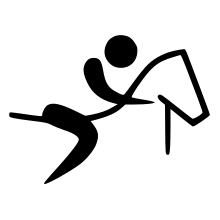

_pictogram.svg.png)
